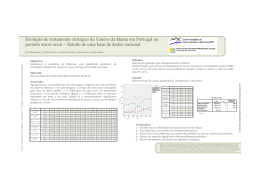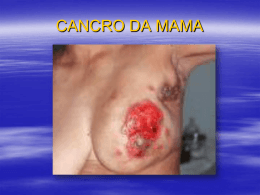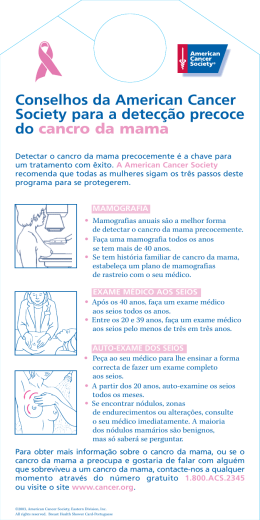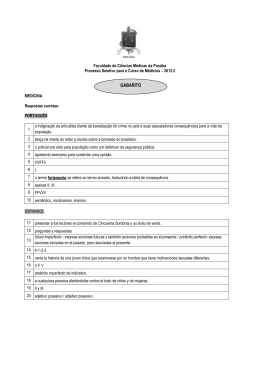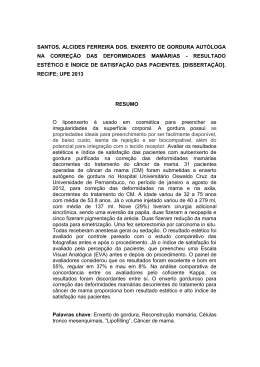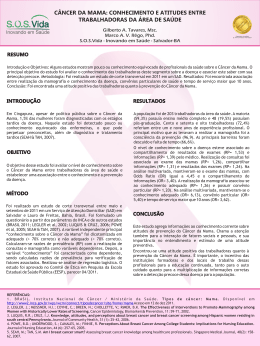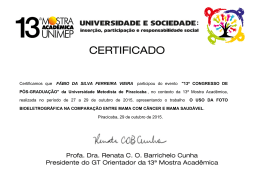EN G L I SH / P O R T U GUE SE Breast Aware BE Conheça a sua mama Be Breast Aware provides information to help answer your questions about breast health. Please share this guide with other women in your life. If you have questions about breast health or have been diagnosed with breast cancer, Willow Breast Cancer Support Canada can provide you with information and support. Breast cancer? Need to talk? Call Willow. 1.888.778.3100 Be Breast Aware fornece informações que ajudam a responder a perguntas relacionadas com a saúde da sua mama. Partilhe este guia com outras mulheres da sua vida. Se tiver perguntas relacionadas com a saúde da sua mama ou se lhe foi diagnosticado cancro da mama, a Willow Breast Cancer Support Canada pode fornecer-lhes informações e apoio. Cancro da mama? Precisa de falar? Telefone para a Willow. 1.888.778.3100 WHAT ARE BREAST HEALTH PRACTICES? Know how your breasts normally look and feel. Your breasts change naturally throughout your life: s Growth at puberty. s Swelling, lumpiness or tenderness before menstrual periods. s Become larger and firmer during pregnancy and breastfeeding. s Become less firm and dense at menopause. Breast changes to look for include: s A breast lump. s Dimpling of the breast. s Changes in breast size. s Changes in the nipple. s Liquid leaking from the nipple. s Changes in skin (e.g. looks like an orange peel). s Redness or discolouration that does not go away. s Any other unusual changes in your breasts. 2 Look and feel for changes and if you notice changes, see your doctor or health care provider. O QUE SÃO PRÁTICAS DA SAÚDE DA MAMA? Saiba qual é a aparência e o toque normal da sua mama. A mama muda naturalmente ao longo da vida: s Crescimento na puberdade. s Inchaço, caroços ou dores antes da menstruação. s Fica maior e mais firme durante a gravidez e a amamentação. s Fica menos firme e densa na menopausa. As alterações que deve procurar na sua mama incluem: s Caroços . s Depressão da mama. s Alterações no tamanho da mama. s Alterações no mamilo. s Líquido que escorre pelo mamilo. s Alterações na pele (efeito casca de laranja). s Vermelhidão ou descoloração que não desaparece. s Quaisquer outras alterações não habituais na sua mama. Observe e sinta as alterações e, se reparar em alguma alteração, consulte o seu médico ou prestador de cuidados de saúde. 3 HOW DO I LOOK AND FEEL FOR BREAST CHANGES? One way to feel your breasts is to use the flat part of your three middle fingers, moving in a circular motion. Use gentle to firm pressure to feel all the breast tissue. s Remember that breast tissue extends up to your collar bone and under your arm pits. s While looking in a mirror, check your breasts for any changes. Leaning forward and changing the position of your arms (hands on hips, arms out at the side, arms raised) may help you see changes in your breasts. s Feel your breasts for changes while lying down, standing, in the bath or shower. Find what is comfortable for you. s If you notice breast changes, see your doctor or health care provider. s 4 COMO VEJO E SINTO AS ALTERAÇÕES NA MAMA? Uma forma de sentir a sua mama é com a parte achatada dos seus três dedos do meio, fazendo movimentos circulares. Exerça uma pressão suave e firme para sentir todo o tecido da mama. s Não se esqueça de que o tecido da sua mama se estende até à clavícula e às axilas. s Enquanto se observa ao espelho, procure alterações na sua mama. Inclinar-se para a frente e mudar a posição dos braços (mãos na anca, braços de lado, braços levantados) pode ajudá-la a ver as alterações na sua mama. s Sinta a sua mama para ver se existem alterações enquanto está deitada, de pé, no banho ou no duche. Descubra o que é confortável para si. s Se reparar em alguma alteração na mama, consulte o seu médico ou prestador de cuidados de saúde. s 5 WHAT ARE THE RISK FACTORS FOR BREAST CANCER? Having certain risk factors increases a woman's chance of developing breast cancer. Risk factors for breast cancer include: s Growing older. s A strong family history of the disease. s Never breastfeeding. s An unhealthy body weight. s Drinking alcohol in excess. s Being inactive. s Tobacco use. DO YOU HAVE QUESTIONS ABOUT RISK FACTORS FOR BREAST CANCER? Call Willow. If you wish to speak in your own language Willow will arrange for an interpreter, free of charge. 1.888.778.3100 6 Remember, having one or more risk factors does not mean you will get breast cancer. Many women who develop breast cancer have no obvious risk factors. QUAIS SÃO OS FACTORES DE RISCO PARA O CANCRO DA MAMA? Expor-se a determinados factores de risco aumenta as hipóteses de uma mulher desenvolver cancro da mama. Os factores de risco do cancro da mama incluem: s Envelhecimento. s Forte historial familiar da doença. s Nunca ter amamentado. s Peso corporal não saudável. s Ingestão de álcool em excesso. s Inactividade. s Tabaco. TEM ALGUMA QUESTÃO SOBRE OS FACTORES DE RISCO DO CANCRO DA MAMA? Telefone para a Willow. Se desejar falar na sua própria língua, a Willow arranjará um intérprete gratuitamente. 1.888.778.3100. Lembre-se: ter um ou mais factores de risco não significa que sofrerá de cancro da mama. Muitas mulheres que desenvolvem cancro da mama não têm factores de risco óbvios. 7 HOW CAN I REDUCE MY RISK OF GETTING BREAST CANCER? Making healthy lifestyle choices may reduce your risk of developing breast cancer and will also help prevent type 2 diabetes, heart disease and stroke. Maintain a healthy weight. Eat a healthy and well-balanced diet that includes 5 to 10 servings of vegetables and fruit every day. s Get active at least three times a week for 30-45 minutes of moderate activity, such as walking. s No more than one alcoholic drink per day. s Be tobacco free. s s For more information about healthy living: s Canada’s Food Guide, www.hc-sc.gc.ca s Canada’s Physical Activity Guide to Healthy Living, www.phac-aspc.gc.ca s s 8 s Eat a healthy diet. Be physically active. Don’t smoke. COMO POSSO REDUZIR O MEU RISCO DE DESENVOLVER CANCRO DA MAMA? Adoptar um estilo de vida saudável poderá reduzir o seu risco de desenvolver cancro da mama e ajudará igualmente a prevenir a diabetes tipo 2, doenças cardíacas e AVC. Mantenha um peso saudável. Faça uma dieta saudável e equilibrada que inclua 5 a 10 porções diárias de legumes e fruta. s Pratique uma actividade moderada, como caminhar, pelo menos três vezes por semana e durante 30-45 minutos. s Não beba mais de uma bebida alcoólica por dia. s Não fume. s s Para mais informações sobre uma vida saudável: s Canada’s Food Guide (Guia Alimentar do Canadá), www.hc-sc.gc.ca s Canada’s Physical Activity Guide to Healthy Living (Guia do Canadá de Actividade Física Para Uma Vida Saudável), www.phac-aspc.gc.ca s s s Coma comida saudável. Faça actividade física. Não fume. 9 WHAT IS BREAST SCREENING? Breast screening is the regular examination of a woman's breasts to find breast cancer early. Breast screening includes: s A physical examination of the breasts (if you have an annual checkup, a physical examination of your breasts may be done by your doctor or nurse). s Mammography. (A breast x-ray that can detect breast cancer before it can be felt. It uses safe doses of radiation.) WHY SHOULD I TAKE PART IN BREAST SCREENING? Regular breast screening can find cancer early. This means there is a better chance of treating the cancer successfully. In Canada, each province provides breast screening programs that do not require a doctor’s referral and are free of charge. For more information, please call Willow at 1.888.778.3100. 10 Do you have questions about the breast screening program in your province? Call Willow, free-of-charge at 1.888.778.3100. O QUE É O RASTREIO DO CANCRO DA MAMA? O rastreio do cancro da mama é o exame regular à mama de uma mulher com vista a detectar, de forma precoce, indícios de cancro da mama. O rastreio do cancro da mama inclui: s um exame físico ao seu peito (se fizer um check-up anual, um exame físico ao seu peito pode ser feito pelo médico ou enfermeiro). s Mamografia. (Um raio-X à mama que consegue detectar o cancro da mama antes de ser sentido. Utiliza doses seguras de radiação). PORQUE TENHO DE FAZER O RASTREIO DO CANCRO DA MAMA? O rastreio regular pode encontrar cancro precocemente. Isto significa que há mais hipóteses de tratar o cancro com sucesso. No Canadá, cada província oferece programas de rastreio do cancro da mama que não requerem credencial médica e que são gratuitos. Para mais informações, ligue para a Willow para o número 1.888.778.3100. Tem alguma questão sobre o programa do rastreio do cancro da mama na sua província? Ligue para a Willow gratuitamente para o número 1.888.778.3100. 11 WHEN SHOULD I HAVE A MAMMOGRAM? s If you are over 40 talk to your doctor or nurse about having a mammogram. HOW DO I GET READY FOR A MAMMOGRAM? On the day of the mammogram: s You will be asked to remove all clothing above your waist. s Do not use deodorants, antiperspirants, body lotions or talcum powders. WHAT HAPPENS WHEN I GO FOR A MAMMOGRAM? A registered radiology technologist specializing in mammography will place your breast on a special x-ray machine. s A plastic plate will be pressed down slowly to flatten your breast and hold it in place for a few seconds. s You will feel some pressure on your breast for a few seconds during the x-ray. This pressure does not harm your breast tissue. s Usually four pictures are taken, two of each breast. s The technologist will check the pictures to make sure they are good enough quality for the radiologist to read. If needed, she will take additional pictures. s Within 1-2 weeks your doctor will receive the results and share them with you. s 12 Take time for breast screening. It may save your life. QUANDO É QUE DEVO FAZER UMA MAMOGRAFIA? s Se tem mais de 40 anos, fale com o seu médico ou enfermeiro para fazer uma mamografia. COMO ME PREPARO PARA UMA MAMOGRAFIA? No dia da mamografia: s Irão pedir-lhe que tire toda a roupa da cintura para cima. s Não utilize desodorizantes, antitranspirantes, loções corporais nem pó de talco. O QUE ACONTECE QUANDO FAÇO UMA MAMOGRAFIA? Um técnico radiologista registado e especializado em mamografias colocará a sua mama numa máquina de raio-X especial. s Uma placa de plástico será comprimida lentamente para achatar a sua mama e imobilizá-la durante alguns segundos. s No decorrer do raio-X, sentirá alguma pressão na mama durante alguns segundos. Esta pressão não prejudicará o tecido da sua mama. s Normalmente, são tiradas quatro imagens, duas de cada mama. s O técnico verificará as imagens para se certificar de que são de boa qualidade para que o radiologista as observe. Se necessário, tirará mais imagens. s No prazo de 1-2 semanas, o seu médico receberá os resultados e partilhá-los-á consigo. s Disponibilize tempo para fazer o rastreio da mama. Pode salvar-lhe a vida. 13 HOW DOES IT FEEL? You will feel some pressure on your breast. It feels similar to a tight blood pressure cuff. A few women experience pain but it lasts only for a few seconds. If you feel pain during the x-ray, tell the technologist. She may be able to adjust the pressure. The two of you can work together to make it as comfortable an experience as possible. Some tips: s Most women’s breasts are tender the week before and after their period. Book your mammogram for a time when your breasts are not so tender. s Ask your pharmacist or health care provider about taking mild pain medication before your mammogram appointment. s Some experts suggest having less caffeine for two weeks before the appointment to help reduce tenderness. 14 If at any age you have concerns about your breast health, talk to your doctor. O QUE SE SENTE? Sentirá alguma pressão na mama. É semelhante a um tensiómetro apertado. Em alguns casos, as mulheres sentem dor mas esta prolongarse-á por apenas alguns segundos. Se sentir dor durante o raio-X, diga ao técnico. Este poderá ajustar a pressão. Os dois podem envidar esforços no sentido de fazer com que seja uma experiência tão confortável quanto possível. Algumas dicas: s As mamas da maioria das mulheres doem na semana antes e depois do período. Marque a sua mamografia para uma altura em que não sinta dor nas mamas. s Aconselhe-se com o seu farmacêutico ou prestador de cuidados de saúde sobre a toma de um medicamento para as dores antes da sua consulta para fazer a mamografia. s Alguns especialistas sugerem que se ingira menos cafeína durante as duas semanas anteriores à consulta para ajudar a reduzir as dores. Se em qualquer idade tiver alguma preocupação sobre a saúde da mama, fale com o seu médico. 15 WILLOW BREAST CANCER SUPPORT CANADA Willow Breast Cancer Support Canada provides confidential support and information to anyone affected by breast cancer. WHY CALL WILLOW? When you call Willow you speak with someone who has had breast cancer, she understands how you feel. s We answer questions about breast health and breast cancer. s We help you understand how to take care of yourself or someone you love. s We will help you find or start a support group in your community. s We can offer you volunteer opportunities at Willow. s All Willow’s services are free of charge. If you wish to speak in your own language, Willow will arrange for an interpreter. 16 Breast cancer? Need to talk? Call Willow. 1.888.778.3100. WILLOW BREAST CANCER SUPPORT CANADA A Willow Breast Cancer Support Canada presta apoio confidencial e informações a qualquer pessoa afectada por cancro da mama. PORQUÊ LIGAR PARA A WILLOW? Quando ligar para a Willow irá falar com alguém que já teve cancro da mama. Ela compreenderá como se sente. s Respondemos a perguntas sobre a saúde da mama e o cancro da mama. s Ajudamo-lo a compreender como deverá tratar-se ou a alguém que ama. s Ajudá-la-emos a encontrar um grupo de apoio na sua comunidade. s Podemos oferecer-lhe oportunidades como voluntária na Willow. s Todos os serviços da Willow são gratuitos. Se desejar falar na sua própria língua, a Willow arranjará um intérprete. Cancro da mama? Precisa de falar? Telefone para a Willow. 1.888.778.3100. 17 Willow Breast Cancer Support Canada 30 St. Patrick Street, 4th Floor Toronto, Ontario M5T 3A3 1.888.778.3100 www.willow.org Charitable Registration / Registo de Beneficência #89551 3737 RR0001 The printing and distribution of this resource was made possible by the generosity of the Avon Foundation for Women - Canada. A impressão e distribuição deste recurso foi possível graças à generosidade da Avon Foundation for Women - Canada. Willow Breast Cancer Support Canada gratefully acknowledges the support of the Ontario Ministry of Health Promotion. A Willow Breast Cancer Support Canada reconhece com gratidão o apoio do Ministério da Promoção da Saúde de Ontário.
Download

